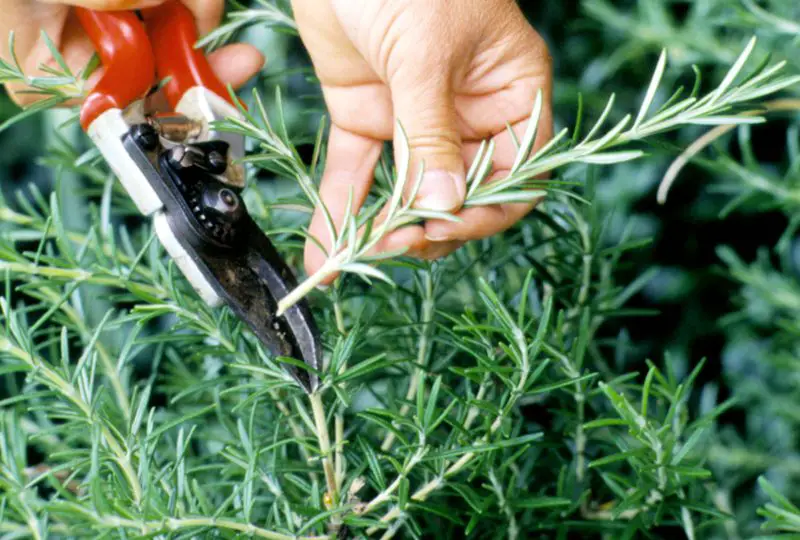 Rosemary is a fragrant, versatile herb cherished for its aromatic leaves and rich flavor. Perfect for enhancing roasted meats, vegetables, soups, and teas, it adds a distinctive touch to any dish. Knowing how to harvest rosemary correctly ensures the plant stays healthy while preserving its vibrant taste and fragrance. Proper harvesting techniques also encourage bushy growth and a continuous supply of fresh leaves, whether grown in garden beds or pots.
Rosemary is a fragrant, versatile herb cherished for its aromatic leaves and rich flavor. Perfect for enhancing roasted meats, vegetables, soups, and teas, it adds a distinctive touch to any dish. Knowing how to harvest rosemary correctly ensures the plant stays healthy while preserving its vibrant taste and fragrance. Proper harvesting techniques also encourage bushy growth and a continuous supply of fresh leaves, whether grown in garden beds or pots.
Timing is essential for maximizing flavor. Harvesting in the early morning, after dew has dried, captures peak essential oils, enhancing aroma and taste. Using clean, sharp scissors or pruning shears prevents plant damage and infection. By following these simple practices, gardeners can enjoy rosemary’s culinary and decorative benefits year-round while keeping plants thriving and lush.
When to Harvest Rosemary
Timing is essential to harvesting rosemary at its peak flavor and aroma. The best time is in the early morning, after the dew has dried but before the heat of the day sets in. Essential oils are most concentrated at this time, which ensures the leaves carry maximum fragrance and taste. Harvesting too late in the day or during extreme heat may reduce the intensity of these oils, affecting both culinary and aromatic qualities. Morning harvests also reduce stress on the plant, allowing it to recover quickly and produce new growth.
Seasonal timing plays a significant role in harvest quality. Rosemary can be harvested throughout the growing season, but young, tender stems are more flavorful than older, woody branches. Pruning in spring encourages vigorous growth, while summer harvests yield robust leaves suitable for cooking and drying. Avoid harvesting more than one-third of the plant at a time to maintain health and prevent stress. Consistent, moderate harvesting encourages dense foliage, enhances the plant’s visual appeal, and extends its lifespan.
Environmental conditions impact harvest success as well. Rosemary thrives in well-draining soil under full sun, and healthy plants produce the most aromatic and flavorful leaves. Avoid harvesting after heavy rain or when plants are water-stressed, as leaves may lack aroma and be more prone to disease. Monitoring soil moisture, sunlight, and seasonal weather ensures a consistent supply of high-quality rosemary. By observing these factors, gardeners can enjoy lush, aromatic leaves for culinary, decorative, and aromatic uses all year round.
Tools and Preparation for Harvesting Rosemary
Using the right tools is essential for a clean and safe rosemary harvest. Sharp scissors or pruning shears are recommended to cut stems without crushing the plant. Dull tools can damage branches, reduce regrowth, and increase the risk of disease. Ensure tools are clean and sanitized before use to prevent spreading pathogens. Regularly maintaining your tools prolongs their effectiveness and keeps your rosemary plants healthy. Choosing the correct cutting angle also reduces stress on the plant and promotes faster recovery.
Preparation before harvesting also plays a key role. Choose a day with dry weather, ideally in the morning after dew has evaporated. This timing preserves essential oils and prevents mold or rot. Inspect plants for damaged or diseased leaves, and remove them before harvesting. Organize your workspace with containers or baskets to hold freshly cut sprigs. Proper planning ensures you gather high-quality rosemary leaves efficiently while protecting the plant from unnecessary stress or injury. Gathering tools, containers, and workspace ahead of time streamlines the harvesting process and helps maintain consistency in quality.
Additional preparation includes selecting the right stems to harvest. Focus on young, tender growth, as these leaves contain the most concentrated flavor and fragrance. Avoid cutting older, woody stems, which are less aromatic and may take longer to regrow. Regularly rotating harvesting areas encourages even growth and prevents over-pruning in one section. By carefully preparing your tools and selecting the best stems, you ensure a successful harvest that maximizes both yield and quality. Proper preparation enhances flavor, aroma, and supports long-term health and productivity of your rosemary plants.
Harvesting Techniques for Maximum Flavor
Proper harvesting techniques are crucial to capture rosemary’s full flavor and aroma. Start by selecting young, tender stems, as these contain the highest concentration of essential oils. Avoid cutting older, woody branches, which are less flavorful and slower to regrow. Always use clean, sharp scissors or pruning shears to make precise cuts. Cutting at a 45-degree angle promotes faster healing and minimizes stress on the plant, ensuring continued growth and healthy foliage.
When harvesting, aim to take no more than one-third of the plant at a time. Over-harvesting can weaken the rosemary, reduce new growth, and compromise its flavor. Focus on outward-facing branches rather than inner woody stems to maintain the plant’s shape and encourage dense growth. Regular harvesting encourages bushiness, produces fresh aromatic leaves, and enhances the overall health of the rosemary. Consistency in technique and timing helps gardeners enjoy a steady supply of flavorful leaves throughout the season.
Additional tips include harvesting during the early morning after dew has dried, when essential oil levels are at their peak. Avoid harvesting during or after heavy rain, as moisture can dilute flavor and increase the risk of mold. Rotate harvesting areas to prevent over-pruning in one section and maintain even growth. By combining proper stem selection, precise cutting, and optimal timing, gardeners can maximize both the yield and flavor of rosemary. These techniques ensure that every sprig harvested delivers rich aroma, robust taste, and long-lasting culinary quality.
Best Time and Frequency for Harvesting Rosemary
Optimal Time of Day for Harvest
Harvesting rosemary at the right time of day ensures maximum flavor and aroma. Early morning, after the dew has dried but before the sun becomes too strong, is ideal. Essential oils, which determine the herb’s fragrance and taste, are most concentrated during this period. Leaves harvested too late in the day or under intense heat may lose their aromatic qualities, reducing culinary value. Choosing the optimal time also reduces plant stress, allowing it to recover quickly and continue producing healthy, tender leaves. Morning harvesting also prevents wilting caused by hot midday sun, preserving both texture and visual appeal of the leaves.
Observing daily weather patterns further enhances harvest quality. Avoid collecting rosemary after heavy rain, as wet leaves are prone to mold and may have diluted flavor. Similarly, harvesting during drought or extreme heat can weaken plants and reduce essential oil content. For consistent, high-quality results, monitor sunlight, temperature, and humidity. Using this approach allows gardeners to harvest rosemary at its peak regularly, ensuring vibrant aroma, robust taste, and maximum essential oil content for culinary, decorative, or aromatic uses. Proper timing also promotes plant longevity and sustained productivity throughout the growing season.
Frequency of Harvest
Regular, moderate harvesting promotes healthy growth and a steady supply of aromatic leaves. Avoid taking more than one-third of the plant at a time, as excessive pruning can weaken rosemary and reduce regrowth. Focus on younger, tender stems while leaving older branches to continue producing energy for the plant. Frequent harvesting encourages bushy growth and prevents the plant from becoming leggy or woody. In addition, maintaining a consistent schedule allows gardeners to anticipate peak growth periods, ensuring that each harvest captures the most flavorful leaves with concentrated essential oils. Proper timing and moderation help maintain the plant’s structure and overall health.
Seasonal variations strongly influence harvest frequency. In spring and summer, when growth is vigorous, more frequent trimming is possible, supporting a continuous supply of fresh rosemary. During colder months, reduce harvesting to avoid stressing the plant and slowing its recovery. Observing growth patterns and environmental conditions helps determine the best harvesting intervals. Consistent, well-planned harvesting prevents over-pruning, maximizes leaf flavor, and maintains long-term plant health. By balancing harvest timing, frequency, and careful plant care, gardeners can enjoy a reliable supply of fresh, aromatic rosemary throughout the year, ideal for cooking, teas, or decorative arrangements.
Drying and Preserving Harvested Rosemary
Drying Rosemary
One of the most effective methods to preserve rosemary’s flavor and aroma for extended periods is by drying the herb carefully. Begin by harvesting healthy, tender stems, avoiding damaged or diseased leaves. Tie small bundles of rosemary together with string and hang them upside down in a cool, dry, and well-ventilated area. Avoid direct sunlight, which can fade color and diminish essential oils, ensuring the leaves retain their vibrant green hue and aromatic potency. For those in humid climates, consider using a food dehydrator or an oven set at a very low temperature, as these methods speed up the process and prevent mold formation.
The drying process typically takes one to two weeks, depending on humidity and air circulation. Once the leaves are brittle and stems snap easily, strip the leaves from the stems and store them in airtight containers. Glass jars or vacuum-sealed bags are ideal for keeping flavor intact. Dried rosemary can be used in cooking, teas, and infusions, maintaining flavor for several months without losing intensity. Proper drying preserves both taste and aroma while reducing the risk of mold or decay. By following these steps and storing dried rosemary in a dark, cool pantry, gardeners ensure a reliable, long-lasting supply of this aromatic herb throughout the year.
Preserving Rosemary in Oil or Vinegar
Preserving rosemary in oil or vinegar is another excellent method for maintaining flavor and fragrance. Start with fresh, clean sprigs and place them in sterilized jars to prevent contamination. Cover completely with high-quality olive oil or vinegar, ensuring no air pockets remain. This method infuses the liquid with rosemary’s natural aroma, creating flavorful oils and dressings for culinary use. The process not only preserves rosemary but also transforms ordinary ingredients into gourmet staples. Infused oils are perfect for drizzling over salads, pasta, or roasted vegetables, while vinegar blends beautifully into marinades and sauces.
For best results, store rosemary-infused oil or vinegar in the refrigerator to prevent spoilage. Oil should be used within two to three weeks, while vinegar can last several months if stored properly. Always label jars with the preparation date to track freshness. This preservation technique is ideal for gardeners with abundant harvests who want to extend rosemary’s use beyond drying. By combining drying with oil or vinegar preservation, rosemary’s aroma, flavor, and versatility are maintained, giving home cooks and gardeners a convenient, aromatic, and long-lasting supply of herbs for everyday dishes and creative recipes.
Using Fresh Rosemary in Cooking and Teas
Cooking with Fresh Rosemary
Fresh rosemary adds depth and complexity to countless recipes, making it a staple in both traditional and modern kitchens. Its strong, pine-like aroma pairs beautifully with roasted meats, potatoes, and vegetables, enhancing flavor without overpowering other ingredients. Simply chop tender leaves finely or add whole sprigs during roasting to release oils gradually. Fresh rosemary can also elevate bread, soups, and stews, giving dishes a rustic and aromatic touch. Chefs often prefer using fresh rosemary at the beginning of cooking to allow flavors to infuse deeply into the food.
Another advantage of cooking with fresh rosemary is its versatility. It can be infused into oils, butter, and sauces to create gourmet accents for everyday meals. Grilled dishes benefit greatly from rosemary sprigs used as skewers, adding subtle smokiness. Fresh rosemary is also a perfect garnish, offering both aroma and visual appeal. Because the herb maintains its strength during cooking, even a small amount can make a big difference. By learning different techniques, home cooks can maximize flavor while enjoying rosemary’s natural fragrance in a variety of meals.
Brewing Rosemary Teas and Infusions
Rosemary tea is a soothing and aromatic beverage valued for its wellness benefits and refreshing taste. To prepare, steep fresh rosemary leaves or sprigs in hot water for several minutes, allowing essential oils to infuse the liquid. The result is an herbal tea with a slightly piney, citrus-like flavor that can be enjoyed hot or chilled. Honey and lemon are often added to balance bitterness and enhance natural sweetness. Drinking rosemary tea is believed to aid digestion, boost circulation, and provide calming effects.
Beyond simple tea, rosemary can be infused with other herbs like mint, lavender, or chamomile for unique blends. Fresh rosemary infusions can also be used as a base for cocktails or mocktails, adding complexity and fragrance to drinks. Herbal enthusiasts appreciate rosemary tea not only for its flavor but also for its connection to relaxation and well-being. Preparing tea from freshly harvested leaves gives gardeners a rewarding way to enjoy their plants beyond cooking. With its rich aroma and subtle flavor, rosemary tea is a timeless beverage that highlights the herb’s versatility and natural charm.
Common Mistakes to Avoid When Harvesting Rosemary
Over-Harvesting Too Frequently
One of the biggest mistakes when working with rosemary is harvesting too frequently or taking too much at one time. Rosemary is a hardy herb, but it still depends on its foliage for photosynthesis and overall strength. Removing more than one-third of the plant at once can weaken its structure, slow down regrowth, and reduce the essential oils responsible for its aroma and flavor. Some gardeners make the mistake of thinking frequent heavy cutting will promote more growth, but the opposite often happens. Over-harvesting can even cause bare patches to develop, making the plant look unattractive and more vulnerable to pests or disease.
The key is balance and timing. Light, consistent harvests encourage bushier growth and keep the plant productive throughout the season. During spring and summer, rosemary grows vigorously and can handle more frequent clipping, while in fall and winter, cutting should be minimal to avoid stressing the plant. Allowing recovery time between harvests gives the plant a chance to rebuild its energy reserves, resulting in healthier, more aromatic leaves. By respecting these natural rhythms and avoiding excess, you preserve the plant’s vitality, ensure a longer lifespan, and enjoy flavorful sprigs of rosemary year-round without long-term damage.
Cutting Woody Stems Instead of Tender Growth
A common mistake when harvesting rosemary is cutting from the old, woody stems instead of focusing on the tender, green shoots. Woody stems are the plant’s structural backbone, and while they provide stability, they do not regenerate as quickly as younger growth. Harvesting too much from these hardened areas can damage the plant’s framework and slow down future production. The leaves on woody stems are also less aromatic, making them less desirable for cooking or preserving. Removing these branches excessively can leave the plant sparse, unattractive, and far less productive.
To avoid this, gardeners should concentrate on harvesting supple stems that bend easily and display vibrant green color. These stems are rich in essential oils, flavorful, and quick to regrow after cutting. Targeting tender growth encourages branching, which leads to a fuller, bushier plant with more leaves available for later harvests. Occasional pruning of woody stems is beneficial for shaping or rejuvenating an older rosemary bush, but it should always be done moderately. By understanding the balance between structural support and new growth, gardeners maintain plant health while enjoying a continuous supply of fresh, aromatic rosemary.
Harvesting at the Wrong Time of Day
Timing is a critical factor in harvesting rosemary, yet many gardeners make the mistake of clipping sprigs at midday or under harsh sun. By this time, essential oils that give rosemary its fragrance and flavor may have already evaporated, leaving the harvested leaves weaker and less potent. Harvesting when plants are stressed by heat also makes it harder for them to recover, reducing overall vigor. Another common error is cutting when leaves are wet from dew, irrigation, or rainfall, which increases the risk of mold and spoilage during storage. These conditions not only lower quality but also reduce the herb’s shelf life.
The best time to harvest rosemary is in the morning, once the dew has dried but before sunlight becomes intense. At this point, essential oils are at peak concentration, ensuring maximum aroma and flavor for cooking, drying, or infusing. Making harvesting a morning ritual also ensures that plants are cut during their healthiest state of the day. By respecting these natural cycles, gardeners consistently achieve higher quality yields, preserve stronger aromas, and maintain more resilient rosemary plants for the long term.
Neglecting Tool Cleanliness and Sharpness
Another often-overlooked mistake when harvesting rosemary is using dull or dirty tools. Dull shears or scissors leave ragged cuts that heal slowly, creating unnecessary stress on the plant. These rough wounds also provide entry points for pests and pathogens, making the plant more susceptible to disease. If tools are contaminated, they can spread fungal spores or bacteria from one plant to another, sometimes leading to widespread problems in the garden. Gardeners who skip tool maintenance may not notice immediate effects, but over time, this habit can severely weaken rosemary plants.
The solution is straightforward: always harvest with clean, sharp tools. Sterilizing blades with rubbing alcohol or a mild bleach solution before and after use prevents disease transmission. Sharp blades create smooth, precise cuts that heal quickly, allowing the plant to recover with minimal stress. This practice not only improves rosemary’s health but also benefits other herbs and shrubs in the garden. With proper care of tools, gardeners can extend plant longevity, maintain vigorous growth, and ensure a steady supply of flavorful rosemary for culinary, medicinal, or decorative purposes.
Storing Freshly Harvested Rosemary
Freshly harvested rosemary can be stored in several ways to extend its usability while preserving its fragrance and taste. The simplest method is to keep sprigs in the refrigerator, wrapped loosely in a slightly damp paper towel and placed inside a resealable plastic bag or airtight container. This method maintains freshness for about one to two weeks. It is important to avoid excess moisture, as overly wet conditions can cause the leaves to darken or develop mold. Regularly checking the sprigs and replacing damp towels when necessary helps maintain the herb’s bright aroma and vibrant appearance.
Another effective storage option is to place rosemary stems in a glass of water, similar to fresh flowers, and cover them loosely with a plastic bag. Kept in the refrigerator, this method keeps the herb fresh for up to two weeks while maintaining essential oil content. For those who use rosemary frequently, freezing sprigs or individual leaves is another long-term solution. Freezing helps preserve oils and fragrance, though the leaves may lose their crisp texture once thawed. Frozen rosemary works especially well in cooked dishes, soups, or stews where texture is less critical.
Proper storage not only ensures rosemary lasts longer but also enhances culinary experiences. Whether kept fresh in the refrigerator, stored in water, or frozen for months of use, each method helps capture the herb’s essence. Gardeners and cooks alike benefit from having a reliable supply of rosemary ready at hand, whether for seasoning meats, infusing oils, or adding aromatic touches to everyday dishes. By choosing the right storage approach, you maximize both flavor and convenience, turning each harvest into a long-lasting kitchen resource.
Creative Ways to Use Rosemary at Home
Rosemary is not only a flavorful herb for the kitchen but also a versatile plant with many uses beyond cooking. One of the most popular applications is in homemade teas and infusions, where fresh or dried sprigs are steeped to create a calming, aromatic drink. Rosemary tea is known for aiding digestion, improving circulation, and providing a gentle boost of energy. Its distinctive aroma also makes it an excellent ingredient in homemade bath salts, herbal sachets, or potpourri, bringing natural fragrance into living spaces while promoting relaxation and stress relief.
In the culinary world, rosemary enhances far more than roasted meats or vegetables. It can be infused into olive oil for salad dressings, added to bread dough for herbal loaves, or even blended into sweet recipes like shortbread or syrups. The herb pairs beautifully with citrus, garlic, and honey, offering endless possibilities for creative flavor combinations. Beyond food, rosemary’s strong fragrance makes it an effective natural insect repellent, often used in homemade sprays or dried bundles placed in cupboards.
Craft enthusiasts also find rosemary useful for decorative and festive purposes. Fresh sprigs can be woven into wreaths, tied into small bundles for gifts, or used as aromatic place settings at dinner tables. These applications highlight the herb’s dual role as both practical and ornamental. By exploring rosemary’s many possibilities, gardeners and home cooks alike can appreciate the full value of each harvest, turning a simple herb into a daily companion for wellness, flavor, and creativity.
Tips for Maximizing Flavor and Aroma
Maximizing rosemary’s flavor and aroma begins with proper harvesting techniques. The essential oils that give rosemary its signature fragrance are most concentrated in young, tender shoots. Cutting these pliable stems instead of older woody branches ensures that the harvested leaves are rich in both flavor and scent. Timing also matters greatly—sprigs should be collected in the morning once the dew has dried but before the midday sun reduces the oils through evaporation. Avoiding over-harvesting is equally important; leaving at least two-thirds of the plant intact allows for continuous regrowth and stronger aroma in future harvests.
Proper handling after harvest also helps preserve rosemary’s intensity. Sprigs should be stored dry and handled gently to avoid bruising, as crushed leaves release oils prematurely and lose potency. For immediate use, keeping rosemary in a slightly damp towel in the refrigerator maintains freshness. If planning to store longer, freezing or drying quickly after harvest captures the oils at their peak. Drying should be done in a shaded, well-ventilated area rather than under direct sun, which can diminish both fragrance and flavor.
Finally, the way rosemary is prepared before use plays a role in its overall aroma. Fresh leaves can be finely chopped to release oils just before cooking, while whole sprigs are best for slow-roasted dishes where the fragrance has time to infuse. Infusing rosemary in oils or butters preserves its flavor for extended use in the kitchen. By combining mindful harvesting, careful storage, and intentional preparation, gardeners and cooks can consistently enjoy rosemary at its most aromatic and flavorful stage.
Sustainability and Year-Round Harvesting
Sustainable rosemary harvesting starts with understanding the plant’s growth cycle and ensuring that each cut supports long-term health. Rather than removing large sections at once, trimming lightly and frequently allows the plant to recover and continue producing throughout the year. Leaving enough foliage for photosynthesis is crucial, as this energy supports both root strength and new shoots. By adopting a patient, measured approach, gardeners not only enjoy consistent yields but also extend the plant’s lifespan, making rosemary a reliable garden companion for many years.
Another key aspect of sustainability is propagation. Rosemary can be easily multiplied through stem cuttings, which ensures a steady supply of plants without needing to purchase new ones. Growing multiple plants reduces the strain on a single shrub, allowing harvests to be spread evenly and encouraging healthier growth overall. In colder climates, container growing makes it possible to bring rosemary indoors during winter, protecting it from frost and ensuring continued availability. This adaptability allows year-round access while preserving the plant’s vitality.
Year-round harvesting also involves adjusting techniques according to the seasons. In spring and summer, rosemary grows vigorously and can tolerate more frequent clipping, while in autumn and winter, harvests should be lighter to prevent stress. Mulching around the base, ensuring proper drainage, and providing occasional pruning for shape further enhance sustainability. By respecting the plant’s seasonal rhythms and adopting propagation strategies, gardeners create a self-sustaining rosemary supply that balances immediate use with long-term productivity.
FAQ About How to Harvest Rosemary
How often should I harvest rosemary without harming the plant?
You can harvest rosemary every one to two weeks during the active growing season. Avoid cutting more than one-third of the plant at once. This balance allows the herb to regenerate quickly, keeps it healthy, and ensures a steady supply of flavorful sprigs throughout the year.
Can I harvest rosemary in winter?
Yes, you can harvest rosemary in winter, but do so sparingly. Growth slows in colder months, so excessive cutting may stress the plant. Focus on taking small amounts of tender sprigs as needed, while leaving enough foliage to help the plant stay strong until spring growth resumes.
What is the best way to store fresh rosemary for a week?
The easiest method is to wrap rosemary sprigs in a slightly damp paper towel and place them in a resealable bag in the refrigerator. This method preserves freshness for up to a week. Avoid storing in too much moisture, which can cause mold or reduce the herb’s natural fragrance.
Should I wash rosemary before storing or drying it?
It’s best to gently rinse rosemary only if it appears dusty or dirty, then pat it completely dry with a towel. Storing or drying wet sprigs can lead to mold growth. Ensuring the herb is fully dry helps maintain its flavor, aroma, and overall quality during storage or preservation.
Can you froze rosemary for long-term use?
Yes, rosemary freezes well and retains much of its aroma and flavor. Simply place whole sprigs or stripped leaves into a freezer-safe bag or ice cube tray with a little olive oil. Frozen rosemary works best in cooked dishes, soups, or stews where texture is less important.
Conclusion
Harvesting and preserving rosemary is both an art and a science, requiring thoughtful timing, gentle techniques, and sustainable practices. By learning when and how to cut, how to store sprigs effectively, and how to maximize flavor and aroma, gardeners can enjoy this versatile herb in countless ways throughout the year. From enhancing meals to crafting natural remedies and decorations, rosemary proves its value well beyond the garden. With mindful care and respect for the plant’s rhythms, every harvest becomes not only a source of fragrance and flavor but also a step toward lasting garden abundance.






